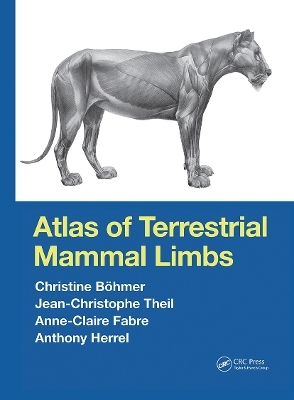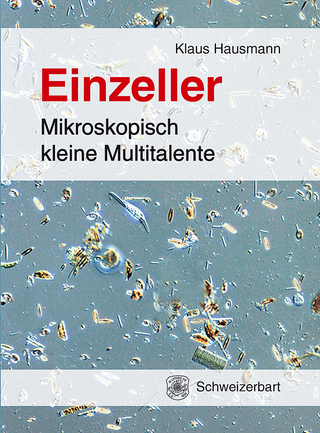
Atlas of Terrestrial Mammal Limbs
CRC Press (Verlag)
978-1-032-24087-9 (ISBN)
Atlas of Terrestrial Mammal Limbs is the first comprehensive and detailed anatomy book on a broad phylogenetic and ecological range of mammals. This extraordinary new work features more than 400 photographs and illustrations visualizing the limb musculature of 28 different species. Standardized views of the dissected bodies and concise text descriptions make it easy to compare the anatomy across different taxa. It provides tables of nomenclature and comparative muscle maps (schematic drawings on the origins and insertions of the muscles onto bones) in a diversity of animals. Atlas of Terrestrial Mammal Limbs is a reliable reference and an indispensable volume for all students and professional researchers in biology, paleontology, and veterinary medicine.
Key Features:
Provides an overview of the anatomy of the mammalian limb
Includes osteological correlates of the limb muscles
Illustrates anatomy in 2D
Guides dissection
Documents anatomical diversity in mammalian limbs
Related Titles:
D. L. France. Human and Nonhuman Bone Identification: A Color Atlas. (ISBN 978-1-4200-6286-1)
S. N. Byers. Forensic Anthropology Laboratory Manual, 4th Edition (ISBN 978-1-1386-9073-8)
S. N. Byers. Introduction to Forensic Anthropology, 5th Edition (ISBN 978-1-1381-8884-6)
R. Diogo, et al. Muscles of Chordates: Development, Homologies, and Evolution (ISBN 978-1-1385-7116-7)
Christine Böhmer is a vertebrate paleobiologist with expertise in anatomy, evolutionary developmental biology(EvoDevo) and functional morphology. She graduated from the Technische Universitat in Munich (BSc) and Ludwig-Maximilians-Universitat in Munich (MSc) (Germany). After a visiting fellowship at the University of Chicago (USA), she went back to Germany and earned her doctoral degree from the Ludwig-Maximilians-Universitat (PhD) in 2013 with summa cum laude. Subsequently, Christine spent one year as postdoctoral researcher at the RIKEN Institute in Kobe (Japan). Since 2015, she works as Postdoc at the Museum National d’Histoire Naturelle in Paris (France). In 2019, she was a visiting professor for vertebrate paleobiology at the University of Vienna (Austria). Recently, Christine was awarded a Marie-Skldowska Curie fellowship from the European Commission. Jean-Christophe Theil. Interested in animals, anatomy and osteology since his childhood he started an osteological collection leading him to learn more about animals. Re-assembling skulls and skeletons of all kinds of vertebrates is the crossing of a scientific and artistic process that he has come to love. During his studies, he met Anthony Herrel who introduced him to the world of muscles. After earning a Master’s degree in Systematics, Evolution and Paleontology at the Museum National d’Histoire Naturelle in Paris, he joined the FUNEVOL team as temporary dissection worker and bone preparator. He is very happy to combine his understanding of both muscles and bones which are very complementary. Anne-Claire Fabre is an evolutionary biologist and functional morphologist principally interested in shape evolution. Her research on macroevolution is highly integrative, linking different research areas in biology in order to understand the evolution of the shape of a structure in relation to development, function and behavior. She earned her PhD from University College London and did postdocs as a Fondation Fyssen fellow at Duke University (USA) and as a Marie-Sklodowska Curie fellow at the Museum National d’Histoire Naturelle (France). She is currently working as a research co-investigator at the Natural History Museum (UK). Anthony Herrel is a research director of the CNRS working at the Museum National d’Histoire Naturelle. His main interests are the evolution of the vertebrate feeding and locomotor systems. He is by training a comparative anatomist with a keen interest in functional morphology and biomechanics. He earned his PhD from the University of Antwerp in Belgium and did postdocs at the University of Antwerp in Belgium, Northern Arizona University, Tulane University and Harvard University in the US before landing a job at the CNRS. He now runs the Function and Evolution team of the UMR7179 at the Museum in Paris.
Introduction
Part I
Chapter 1 Limbs and Locomotion
Chapter 2 Comparative Anatomy
2.1 Anatomical Terms of Location
2.2 Limb skeleton
2.3 Limb musculature
2.4 Muscle maps
Part II
Chapter 1 Martes foina (European stone marten)
Chapter 2 Meles meles (European badger)
Chapter 3 Nasua nasua (South American coati)
Chapter 4 Potos flavus (Kinkajou)
Chapter 5 Cuon alpinus (Dhole)
Chapter 6 Vulpes vulpes (Red fox)
Chapter 7 Herpestes auropunctatus (Small Indian mongoose)
Chapter 8 Cryptoprocta ferox (Fossa)
Chapter 9 Hyaena hyaena (Striped hyena)
Chapter 10 Acinonyx jubatus (Cheetah)
Chapter 11 Panthera leo (Lion)
Chapter 12 Manis tricuspis (Tree pangolin)
Chapter 13 Sus scrofa (Wild boar)
Chapter 14 Capreolus capreolus (European roe deer)
Chapter 15 Erinaceus europaeus (European hedgehog)
Chapter 16 Chiropotes satanas (Brown-bearded saki)
Chapter 17 Cuniculus oryctolagus (European rabbit)
Chapter 18 Laonastes aenigmamus (Laotian rock rat or kha-nyou)
Chapter 19 Octodon degus (Degu)
Chapter 20 Sciurus vulgaris (Eurasion red squirrel)
Chapter 21 Pedetes capensis (Springhare)
Chapter 22 Mesocricetus auratus (Golden hamster)
Chapter 23 Meriones unguiculatus (Mongolian gerbil)
Chapter 24 Rattus norvegicus (Norway rat)
Chapter 25 Elephantulus brachyrhynchus (Short-snouted elephant shrew)
Chapter 26 Bradypus tridactylus (Pale-Throated Three-Toed sloth)
Chapter 27 Dasyurus viverrinus (Easter quoll)
Chapter 28 Philander opoussum (Gray four-eyed opossum)
Part III
Muscle synonyms
Non-exhaustive list of references on mammalian limb muscle anatomy
Index
| Erscheinungsdatum | 14.12.2021 |
|---|---|
| Zusatzinfo | 369 Illustrations, color; 46 Illustrations, black and white |
| Verlagsort | London |
| Sprache | englisch |
| Maße | 210 x 280 mm |
| Gewicht | 743 g |
| Themenwelt | Naturwissenschaften ► Biologie ► Zellbiologie |
| Naturwissenschaften ► Biologie ► Zoologie | |
| ISBN-10 | 1-032-24087-3 / 1032240873 |
| ISBN-13 | 978-1-032-24087-9 / 9781032240879 |
| Zustand | Neuware |
| Haben Sie eine Frage zum Produkt? |
aus dem Bereich


